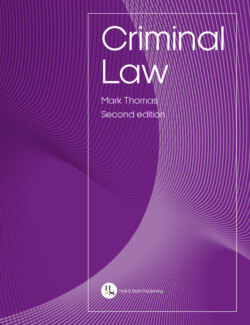Читать книгу Criminal Law - Mark Thomas - Страница 11
На сайте Литреса книга снята с продажи.
1.2.1 ‘Substantive criminal law’
ОглавлениеThe term ‘substantive criminal law’ is used here to distinguish it from the wider concept of the criminal law, incorporating criminal procedure and the law of evidence. Substantive criminal law refers to the criminal offences that exist in our legal system and the elements that must exist in order for an individual to be liable for those offences. The term ‘liability’ will feature throughout this text and simply refers to the legal obligations or responsibilities that may arise against a particular individual. In the context of the criminal law specifically, ‘liability’ means ‘responsibility for illegal behaviour that causes harm or damage to someone or something’ (Cambridge Business English Dictionary (CUP, 2011)).
We can helpfully distinguish the substantive criminal law from other areas by observing the following table.
Table 1.1Distinguishing the substantive criminal law
| Term | Explanation |
| Substantive criminal law | The law relating to the manner in which criminal offences are defined and the elements of the offence necessary in order for an individual to be found liable. |
| Criminal procedure | The law relating to court structure and the progression of a criminal case through the criminal justice system, including the investigation of the crime by the police, the prosecution of offenders and criminal appeals. Criminal procedure also includes sentencing and the principles behind sentencing powers. |
| Criminal evidence | The law relating to the material that may be produced at trial in order to prove, or disprove, a particular issue in a criminal offence. The law of evidence is often referred to as ‘adjectival’ in nature. |
| Criminal justice | Criminal justice refers to the theory behind the criminal law in terms of its operation and its rationale. Criminal justice also includes a concept known as ‘restorative justice’ which is concerned with bringing those harmed by crime and those responsible for the harm into communication, enabling everyone affected by a particular incident to play a part in repairing the harm and finding a positive way forward. |
| Criminology | Criminology refers to the socio-legal study of why crime is committed, the reasons behind the commission of crime by certain individuals or groups of individuals and how legal policy may be implemented to prevent the commission of offences. A number of ‘strands’ of criminology exist, for example penology (the study of punishment of crime and prison management) and ‘deviance’ (the study of actions that violate social norms). |
An example may assist you in understanding the focus of this book.
example
Jack and Jill go up the hill to fetch a pail of water. Jill pushes Jack down the hill and he is injured as a result (he breaks his crown).
In this very simple scenario, our concern is whether Jill, through her actions in pushing Jack down the hill, is criminally liable for an offence. That is the focus of the substantive law. In order to determine Jill’s liability, we would have to establish:
•what kind or ‘category’ of offence Jill may be liable for;
•what the elements of that offence are and whether Jill satisfies those elements; and
•whether Jill has a potential defence to the charge against her.
Although a simple factual scenario, a number of questions should hopefully spring to mind. For example:
•Did Jill intend to push Jack down the hill or did she just intend to push him to the floor?
•Did Jill intend to push Jack at all or were her actions an accident?
•What level of harm did Jack suffer? Was he seriously hurt or just bruised?
•Did the pail of water fall down with Jack, and did that cause him any harm that would not have been caused had he not held the pail of water?
These questions, although abstract in nature, are essential for assessing the true extent of Jill’s liability and the direction the criminal law will take in relation to her activities.
As a result, we are not concerned, for example, with:
•how it might be proved that Jill pushed Jack down the hill, eg through the testimony of an eye witness – a matter for the law of evidence;
•how Jill will be charged, prosecuted and sentenced for the offence in question – a matter for criminal procedure and sentencing;
•why Jill pushed Jack down the hill – a matter for the study of criminology.
Although our concern is with the substantive law, the remainder of this chapter will explain a number of key concepts that will help you to understand the wider context and dynamism of the criminal law in England and Wales.
The chapter will conclude with an overview of the three key components to establishing the criminal liability of an individual. This will then provide us with a comfortable transition into a more detailed appreciation of the substantive criminal law.
